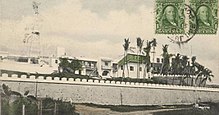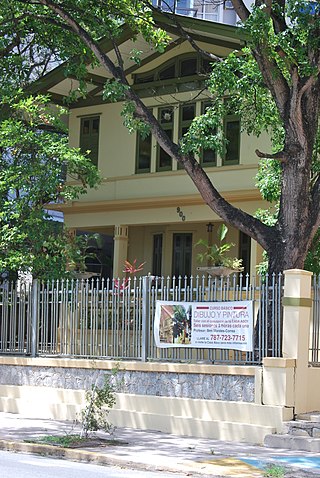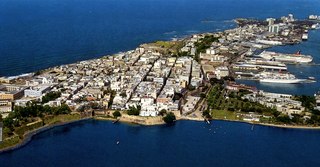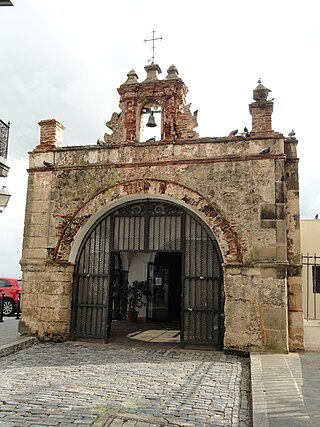


Casa Blanca is a historic house museum situated in Old San Juan, the historic colonial district of San Juan, Puerto Rico.



Casa Blanca is a historic house museum situated in Old San Juan, the historic colonial district of San Juan, Puerto Rico.
Constructed in 1521, Casa Blanca served as the initial fortification for the San Juan islet and was intended to be the residence of Juan Ponce de León and his family. However, de León passed away during an expedition to Florida without ever residing in the house. Subsequently, it sheltered his descendants until the mid-18th century.
Originally constructed of wood, Casa Blanca was rebuilt in stone and masonry after a fire. During conflicts with the Taíno, it provided refuge, and was the venue for negotiations between the conquistadores and a commission of caciques (chieftains) facilitated a resolution to a brief uprising [1] [ citation needed ].
When the capital transitioned to the San Juan Islet in 1521, Casa Blanca became the first governor's residence in Puerto Rico. Despite undergoing numerous refurbishments over five centuries, it remained the governors' residence until the mid-1700s when Castle-Fortress of St. Catherine was modernized and reborn as the Royal Site of the Palace of St. Catherine of Siena. Subsequently, Casa Blanca housed various military and chivalry organizations before gradually falling into disuse post-World War II. It was rejuvenated by the Puerto Rican Institute of Culture, and its gardens, planted by General Brooks (the first American Military governor of the island in the 20th century), were preserved. [1]
In 1967, Casa Blanca was transferred to the Puerto Rican government and designated a historical monument. It was documented in the Historic American Buildings Survey in 1981 and currently operates as a museum showcasing 16th and 17th-century artifacts, administered by the Institute of Puerto Rican Culture. [2]

San Juan is the capital city and most populous municipality in the Commonwealth of Puerto Rico, an unincorporated territory of the United States. As of the 2020 census, it is the 57th-largest city under the jurisdiction of the United States, with a population of 342,259. San Juan was founded by Spanish colonists in 1521, who called it Ciudad de Puerto Rico.

La Fortaleza, also known as Palacio de Santa Catalina, is the official residence and workplace of the governor of Puerto Rico. Located in the historical district of Old San Juan in the capital city of San Juan, it has served as the residence of the governor since the 16th century, making it the oldest executive mansion in continuous use in the New World. Built between 1533 and 1540 by orders of Charles I of Spain, the structure was the first fortification constructed by the Spanish on San Juan Islet to defend San Juan Bay, the harbor of Old San Juan. La fortaleza, alongside El Morro, San Cristóbal, El Cañuelo, and other forts part of the Walls of Old San Juan, protected strategically and militarily important Puerto Rico, or La Llave de las Indias, from invasion by competing world powers and harassment by privateers and pirates during the Age of Sail. It was designated a World Heritage Site by UNESCO in 1983 as part of La Fortaleza and San Juan National Historic Site.
Juan Ponce de León II (1524–1591) was a Spanish official and an acting governor of Puerto Rico. He was the first acting governor to be born on the island.

Old San Juan is a historic district located at the "northwest triangle" of the islet of San Juan in San Juan. Its area roughly correlates to the Ballajá, Catedral, Marina, Mercado, San Cristóbal, and San Francisco sub-barrios (sub-districts) of barrio San Juan Antiguo in the municipality of San Juan, Puerto Rico.

San Juan National Historic Site in the Old San Juan section of San Juan, Puerto Rico, is a National Park Service-managed historic site which preserves and interprets the Spanish colonial-era fortification system of the city of San Juan, and features structures such as the San Felipe del Morro and San Cristóbal fortresses. This fortification system is the oldest European construction under United States jurisdiction and one of the oldest in the New World. This national historic site, together with La Fortaleza, have been designated a UNESCO World Heritage Site since 1983.

The Aboy-Lompré Residence, also known as the Aboy House, is a historic house built in San Juan, Puerto Rico between 1910 and 1912 for the Aboy-Ferrer Family. The house now hosts several cultural and religious institutions including the Shaare Zedeck Synagogue and the Jewish Community Center of Puerto Rico, and a photojournalism museum.

Puerta de Tierra is a subbarrio (subdistrict) occupying the eastern portion of the Islet of San Juan and the barrio of San Juan Antiguo in the municipality of San Juan, Puerto Rico. The name Puerta de Tierra derives from the former eastern gated entrance to the walled city of San Juan where Plaza Colón is today. With a population of 2,924 as of 2010, this is the most populated area of San Juan Antiguo. On October 15, 2019, it was added to the National Register of Historic Places.

San Juan Islet is a 3-square-mile (7.8 km2) islet or small island on San Juan Bay in the Atlantic coast of northern Puerto Rico. Home to Old San Juan, it is the site of the oldest permanent European settlement in Puerto Rico (1521), and the second oldest European settlement in the West Indies after Santo Domingo (1496). Due to its strategic location in the Caribbean during the Spanish colonization of the Americas, it is home to a city wall and a number of militaristic buildings such as El Morro Castle. Today, it is also home to many of Puerto Rico's government buildings such as the territory's capitol building.

The Catedral Basílica Metropolitana de San Juan Bautista, or in English, Metropolitan Cathedral Basilica of Saint John the Baptist, is the Catholic cathedral for the Archdiocese of San Juan de Puerto Rico. It is one of the oldest buildings in Old San Juan, the oldest cathedral in the United States, and the second-oldest cathedral in the Americas.

Caparra is an archaeological site in the municipality of Guaynabo, Puerto Rico. It was declared a U.S. National Historic Landmark in 1994. The site contains the remains of the first Spanish capital of the island, settled in 1508 and officially abandoned in 1521. It represents the oldest known European settlement on United States territory.

San José Church, located in Old San Juan within the historic colonial zone of the capital of Puerto Rico, is one of the first significant works of architecture on the island. The church is one of the earliest surviving examples of 16th-century Spanish Gothic architecture in the Western hemisphere.

The San Germán Historic District is a 36-acre (15 ha) historic district located in the western section of the town of San Germán, Puerto Rico. The district was added to both the National Register of Historic Places and the Puerto Rico Register of Historic Sites and Zones in 1994. The district contains more than 100 significant buildings, including the Church San Germán de Auxerre and the Convento de Porta Coeli.

The Instituto de Cultura Puertorriqueña, or ICP for short, is an institution of the Government of Puerto Rico responsible for the establishment of the cultural policies required in order to study, preserve, promote, enrich, and diffuse the cultural values of Puerto Rico. Since October 1992, its headquarters have been located at the site of the old colonial Spanish Welfare House in Old San Juan.

The Museo de la Masacre de Ponce is a human rights museum and historic building in Ponce, Puerto Rico. It depicts the history and events surrounding the Ponce massacre, which occurred in broad daylight on Palm Sunday in 1937. The museum is housed inside the building where the event itself occurred, with one of its sections devoted to the Nationalist leader, Pedro Albizu Campos. It also documents the blacklisting of Puerto Rican Nationalists performed by the United States, as well as hosting a considerable number of photos from the Nationalist era.

Casa Paoli is a historic house and biographical museum in barrio Cuarto, Ponce, Puerto Rico, in the Ponce Historic Zone. The house is significant as the birthplace of Antonio Paoli (1871–1946), a tenor who was the "first Puerto Rican to reach international recognition in the performing arts" and "one of the most outstanding opera singers of all times". The house was the childhood home of the artist and he was introduced to art and opera at this house during his formative years. In 1987, the house was turned into a museum to honor the career of Antonio Paoli. The building was listed on the U.S. National Register of Historic Places in 2009.

The Museo de la Música Puertorriqueña is a museum in Ponce, Puerto Rico, that showcases the development of Puerto Rican music, with displays of Taíno, Spanish, and African musical instruments that were played in the romantic danza genre, the favorite music of 19th-century Puerto Rican high society, as well as the more African-inspired bomba and plena styles. Also on display are memorabilia of composers and performers. The Museum traces the rich musical history of Puerto Rico through memorabilia of prominent musicians and displays of the musical instruments associated with the three genres of music that originated in this Caribbean island.
The following is a timeline of the history of the municipality of San Juan, Puerto Rico.
Spanish settlement of Puerto Rico began in the early 1500s shortly after the formation of the Spanish state in 1493 and continues to the present day.

Capilla del Cristo, also called Capilla del Santo Cristo de la Salud is a small chapel / museum located in the Old San Juan, Puerto Rico. Built in the 18th century and saved from demolition in the 20th century and preserved, the structure has become a cultural icon of Puerto Rico. Most of the articles located at its altar are from 1753. Travel guides list Capilla del Cristo as one of the must-see places of Old San Juan.

Paseo de la Princesa, is a partially waterside 19th-century pedestrian promenade about .50 miles (0.80 km) in length, located in the historic district of Old San Juan in Puerto Rico. Constructed between 1852 and 1854 in honor of Queen Isabella II of Spain’s first-born, Princess of Asturias Infanta Isabel, the promenade runs adjacent and parallel to the southwestern section of the Walls of Old San Juan. Lined with Victorian lampposts and benches, large trees and gardens, and varying fountains and sculptures, it hosts food and artisan vendors, musical and theatrical entertainers, and cultural restaurants and festivals.
![]() This article incorporates public domain material from Historic American Buildings Survey. National Park Service.
This article incorporates public domain material from Historic American Buildings Survey. National Park Service.